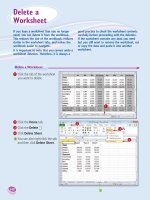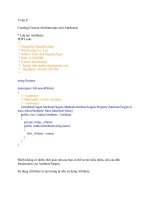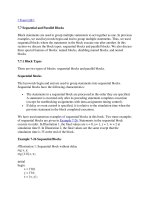Tài liệu Database Systems - Part 11 doc
Bạn đang xem bản rút gọn của tài liệu. Xem và tải ngay bản đầy đủ của tài liệu tại đây (309.34 KB, 30 trang )
COP 4710: Database Systems (Day 11) Page 1 Mark Llewellyn
COP 4710: Database Systems
Spring 2004
Introduction to Normalization – Part 2
BÀI 11, 1 ngày
COP 4710: Database Systems
Spring 2004
Introduction to Normalization – Part 2
BÀI 11, 1 ngày
School of Electrical Engineering and Computer Science
University of Central Florida
Instructor : Mark Llewellyn
CC1 211, 823-2790
/>COP 4710: Database Systems (Day 11) Page 2 Mark Llewellyn
•
Third Normal Form (3NF) is based on the concept of a
transitive dependency.
•
Given a relation scheme R with a set of functional
dependencies F and subset X ⊆ R and an attribute A ∈R.
A is said to be transitively dependent on X if there exists
Y ⊆ R with X → Y, Y X → X and Y → A and A ∉
X∪Y.
•
An alternative definition for a transitive dependency is: a
functional dependency X → Y in a relation scheme R is a
transitive dependency if there is a set of attributes Z ⊆ R
where Z is not a subset of any key of R and yet both X →
Z and Z → Y hold in F.
Third Normal Form (3NF)
COP 4710: Database Systems (Day 11) Page 3 Mark Llewellyn
•
A relation scheme R is in 3NF with respect to a set of functional
dependencies F, if whenever X → A holds either: (1) X is a
superkey of R or (2) A is a prime attribute.
•
Alternative definition: A relation scheme R is in 3NF with respect
to a set of functional dependencies F if no non-prime attribute is
transitively dependent on any key of R.
Example: Let R = (A, B, C, D)
K = {AB}, F = {AB → CD, C → D, D → C}
then R is not in 3NF since C → D holds and C is not a superkey of
R.
Alternatively, R is not in 3NF since AB → C and C → D and thus
D is a non-prime attribute which is transitively dependent on the key
AB.
Third Normal Form (3NF) (cont.)
COP 4710: Database Systems (Day 11) Page 4 Mark Llewellyn
•
What does 3NF do for us? Consider the following
database:
assign(flight, day, pilot-id, pilot-name)
K = {flight day}
F = {pilot-id → pilot-name, pilot-name → pilot-id}
Why Third Normal Form?
flight day pilot-id pilot-name
112 Feb.11 317 Mark
112 Feb. 12 246 Kristi
114 Feb.13 317 Mark
COP 4710: Database Systems (Day 11) Page 5 Mark Llewellyn
Why Third Normal Form? (cont.)
flight day pilot-id pilot-name
112 Feb.11 317 Mark
112 Feb. 12 246 Kristi
114 Feb.13 317 Mark
112 Feb. 11 319 Mark
Since {flight day} is key, clearly {flight day} → pilot-name.
But in F we also know that pilot-name → pilot-id, and
we have that {flight day} → pilot-id.
Now suppose the highlighted tuple is added to this instance.
is added. The fd pilot-name → pilot-id is violated by this
insertion. A transitive dependency exists since: pilot-id →
pilot-name holds and pilot-id is not a superkey.
COP 4710: Database Systems (Day 11) Page 6 Mark Llewellyn
•
Boyce-Codd Normal Form (BCNF) is a more stringent
form of 3NF.
•
A relation scheme R is in Boyce-Codd Normal Form
with respect to a set of functional dependencies F if
whenever X → A hold and A X, then X is a superkey ⊈
of R.
Example: Let R = (A, B, C)
F = {AB → C, C → A}
K =
R is not in BCNF since C → A holds and C is not a
superkey of R.
Boyce-Codd Normal Form (BCNF)
{AB}
COP 4710: Database Systems (Day 11) Page 7 Mark Llewellyn
•
Notice that the only difference in the definitions of 3NF
and BCNF is that BCNF drops the allowance for A in X
→ A to be prime.
•
An interesting side note to BCNF is that Boyce and Codd
originally intended this normal form to be a simpler form
of 3NF. In other words, it was supposed to be between
2NF and 3NF. However, it was quickly proven to be a
more strict definition of 3NF and thus it wound up being
between 3NF and 4NF.
•
In practice, most relational schemes that are in 3NF are
also in BCNF. Only if X → A holds in the schema where
X is not a superkey and A is prime, will the schema be in
3NF but not in BCNF.
Boyce-Codd Normal Form (BCNF) (cont.)
COP 4710: Database Systems (Day 11) Page 8 Mark Llewellyn
•
The basic goal of relational database design should be to
ensure that every relation in the database is either in 3NF
or BCNF.
•
1NF and 2NF do not remove a sufficient number of the
update anomalies to make a significant difference,
whereas 3NF and BCNF eliminate most of the update
anomalies.
•
As we’ve mentioned before, in addition to ensuring the
relation schemas are in either 3NF or BCNF, the designer
must also ensure that the decomposition of the original
database schema into the 3NF or BCNF schemas
guarantees that the decomposition have (1) the lossless
join property (also called a non-additive join property)
and (2) the functional dependencies are preserved across
the decomposition.
Moving Towards Relational Decomposition
COP 4710: Database Systems (Day 11) Page 9 Mark Llewellyn
•
There are decomposition algorithms that will guarantee a
3NF decomposition which ensures both the lossless join
property and preservation of the functional dependencies.
•
However, there is no algorithm which will guarantee a
BCNF decomposition which ensures both the lossless
join property and preserves the functional dependencies.
There is an algorithm that will guarantee BCNF and the
lossless join property, but this algorithm cannot guarantee
that the dependencies will be preserved.
•
It is for this reason that many times, 3NF is as strong a
normal form as will be possible for a certain set of
schemas, since an attempt to force BCNF may result in
the non-preservation of the dependencies.
•
In the next few pages we’ll look at these two properties
more closely.
Moving Towards Relational Decomposition (cont.)
COP 4710: Database Systems (Day 11) Page 10 Mark Llewellyn
•
Whenever an update is made to the database, the DBMS
must be able to verify that the update will not result in an
illegal instance with respect to the functional
dependencies in F
+
.
•
To check updates in an efficient manner the database
must be designed with a set of schemas which allows for
this verification to occur without necessitating join
operations.
•
If an fd is “lost”, the only way to enforce the constraint
would be to effect a join of two or more relations in the
decomposition to get a “relation” that includes all of the
determinant and consequent attributes of the lost fd into a
single table, then verify that the dependency still holds
after the update occurs. Obviously, this requires too
much effort to be practical or efficient.
Preservation of the Functional Dependencies
COP 4710: Database Systems (Day 11) Page 11 Mark Llewellyn
•
Informally, the preservation of the dependencies means
that if X → Y from F appears either explicitly in one of
the relational schemas in the decomposition scheme or
can be inferred from the dependencies that appear in
some relational schema within the decomposition
scheme, then the original set of dependencies would be
preserved on the decomposition scheme.
•
It is important to note that what is required to preserve
the dependencies is not that every fd in F be explicitly
present in some relation schema in the decomposition,
but rather the union of all the dependencies that hold on
all of the individual relation schemas in the
decomposition be equivalent to F (recall what
equivalency means in this context).
Preservation of the Functional Dependencies (cont.)
COP 4710: Database Systems (Day 11) Page 12 Mark Llewellyn
•
The projection of a set of functional
dependencies onto a set of attributes Z, denoted
F[Z] (also sometime as π
Z
(F)), is the set of
functional dependencies X → Y in F
+
such that X
∪ Y ⊆ Z.
•
A decomposition scheme γ = {R
1
, R
2
, …, R
m
} is
dependency preserving with respect to a set of
fds F if the union of the projection of F onto each
R
i
(1≤ i ≤ m) in γ is equivalent to F.
(F[R
1
] ∪ F[R
2
] ∪ … ∪ F[R
m
])
+
= F
+
Preservation of the Functional Dependencies (cont.)
COP 4710: Database Systems (Day 11) Page 13 Mark Llewellyn
•
It is always possible to find a dependency
preserving decomposition scheme D with respect
to a set of fds F such that each relation schema in
D is in 3NF.
•
In a few pages, we will see an algorithm that
guarantees a 3NF decomposition in which the
dependencies are preserved.
Preservation of the Functional Dependencies (cont.)
COP 4710: Database Systems (Day 11) Page 14 Mark Llewellyn
Algorithm for Testing the Preservation of Dependencies
Algorithm Preserve
// input: a decomposition D= (R
1
, R
2
, …, R
k
), a set of fds F, an fd X → Y
// output: true if D preserves F, false otherwise
Preserve (D , F, X → Y)
Z = X;
while (changes to Z occur) do
for i = 1 to k do // there are k schemas in D
Z = Z ∪ ( (Z ∩ R
i
)
+
∩ R
i
)
endfor;
endwhile;
if Y ⊆ Z
then return true; // Z ⊨ X → Y
else return false;
end.
COP 4710: Database Systems (Day 11) Page 15 Mark Llewellyn
•
The set Z which is computed is basically the
following:
•
Note that G is not actually computed but merely
tested to see if G covers F. To test if G covers F
we need to consider each fd X→Y in F and
determine if contains Y.
•
Thus, the technique is to compute without
having G available by repeatedly considering the
effect of closing F with respect to the projections
of F onto the various R
i
.
How Algorithm Preserves Works
[ ]
k
1i
i
RFG
=
=
+
G
X
+
G
X
COP 4710: Database Systems (Day 11) Page 16 Mark Llewellyn
Let R = (A, B, C, D)
F = {A→B, B→C, C→D, D→A}
D = {(AB), (BC), (CD)}
G = F[AB] ∪ F[BC] ∪ F[CD] Z = Z ∪ ((Z ∩ R
i
)
+
∩ R
i
)
Test for each fd in F.
Test for A→B
Z = A,
= {A} ∪ ((A ∩ AB)
+
∩ AB)
= {A} ∪ ((A)
+
∩ AB)
= {A} ∪ (ABCD ∩ AB)
= {A} ∪ {AB}
= {AB}
A Hugmongously Big Example
COP 4710: Database Systems (Day 11) Page 17 Mark Llewellyn
Z = {AB}
= {AB} ∪ ((AB ∩ BC)
+
∩ BC)
= {AB} ∪ ((B)
+
∩ BC)
= {AB} ∪ (BCDA ∩ BC)
= {AB} ∪ {BC}
= {ABC}
Z = {ABC}
= {ABC} ∪ ((ABC ∩ CD)
+
∩ CD)
= {ABC} ∪ ((C)
+
∩ CD)
= {ABC} ∪ (CDAB ∩ CD)
= {ABC} ∪ {CD}
= {ABCD}
G covers A →B
A Hugmongously Big Example (cont.)
COP 4710: Database Systems (Day 11) Page 18 Mark Llewellyn
Test for B→C
Z = B,
= {B} ∪ ((B ∩ AB)
+
∩ AB)
= {B} ∪ ((B)
+
∩ AB)
= {B} ∪ (BCDA ∩ AB)
= {B} ∪ {AB}
= {AB}
Z = {AB}
= {AB} ∪ ((AB ∩ BC)
+
∩ BC)
= {AB} ∪ ((B)
+
∩ BC)
= {AB} ∪ (BCDA ∩ BC)
= {AB} ∪ {BC}
= {ABC}
Z = {ABC}
= {ABC} ∪ ((ABC ∩ CD)
+
∩ CD)
= {ABC} ∪ ((C)
+
∩ CD)
= {ABC} ∪ (CDAB ∩ CD)
= {ABC} ∪ {CD}
= {ABC} So G covers B →C
A Hugmongously Big Example (cont.)
COP 4710: Database Systems (Day 11) Page 19 Mark Llewellyn
Test for C→D
Z = C,
= {C} ∪ ((C ∩ AB)
+
∩ AB)
= {C} ∪ ((∅)
+
∩ AB)
= {C} ∪ (∅)
= {C}
Z = {C}
= {C} ∪ ((C ∩ BC)
+
∩ BC)
= {C} ∪ ((C)
+
∩ BC)
= {C} ∪ (CDAB ∩ BC)
= {C} ∪ {BC}
= {BC}
Z = {BC}
= {BC} ∪ ((BC ∩ CD)
+
∩ CD)
= {BC} ∪ ((C)
+
∩ CD)
= {BC} ∪ (CDAB ∩ CD)
= {BC} ∪ {CD}
= {BCD} So G covers C →D
A Hugmongously Big Example (cont.)
COP 4710: Database Systems (Day 11) Page 20 Mark Llewellyn
Test for D→A
Z = D,
= {D} ∪ ((D ∩ AB)
+
∩ AB)
= {D} ∪ ((∅)
+
∩ AB)
= {D} ∪ (∅)
= {D}
Z = {D}
= {D} ∪ ((D ∩ BC)
+
∩ BC)
= {D} ∪ ((∅)
+
∩ BC)
= {D} ∪ (∅)
= {D}
Z = {D}
= {D} ∪ ((D ∩ CD)
+
∩ CD)
= {D} ∪ ((D)
+
∩ CD)
= {D} ∪ (DABC ∩ CD)
= {D} ∪ {CD}
= {DC} Changes made to G so continue.
A Hugmongously Big Example (cont.)
COP 4710: Database Systems (Day 11) Page 21 Mark Llewellyn
Test for D→A continues on a second pass through D.
Z = DC,
= {DC} ∪ ((DC ∩ AB)
+
∩ AB)
= {DC} ∪ ((∅)
+
∩ AB)
= {DC} ∪ (∅)
= {DC}
Z = {DC}
= {DC} ∪ ((DC ∩ BC)
+
∩ BC)
= {DC} ∪ ((C)
+
∩ BC)
= {D} ∪ (CDAB ∩ BC)
= {D} ∪ (BC)
= {DBC}
Z = {DBC}
= {DBC} ∪ ((DBC ∩ CD)
+
∩ CD)
= {DBC} ∪ ((CD)
+
∩ CD)
= {DBC} ∪ (CDAB ∩ CD)
= {DBC} ∪ {CD}
= {DBC} Again changes made to G so continue.
A Hugmongously Big Example (cont.)
COP 4710: Database Systems (Day 11) Page 22 Mark Llewellyn
Test for D→A continues on a third pass through D.
Z = DBC,
= {DBC} ∪ ((DBC ∩ AB)
+
∩ AB)
= {DBC} ∪ ((B)
+
∩ AB)
= {DBC} ∪ (BCDA ∩ AB)
= {DBC} ∪ (AB)
= {DBCA}
Finally, we’ve included every attribute in R.
Thus, G covers D →A.
Thus, D preserves the functional dependencies in F.
A Hugmongously Big Example (cont.)
Practice Problem: Determine if D preserves the dependencies in F given:
R = (C, S, Z)
F = {CS →Z, Z→C}
D = {(SZ), (CZ)} Solution in next set of notes!
COP 4710: Database Systems (Day 11) Page 23 Mark Llewellyn
Algorithm for Testing for the Lossless Join Property
Algorithm Lossless
// input: a relation schema R= (A
1
, A
2
, …, A
n
), a set of fds F, a decomposition
// scheme D = {R
1
, R
2
, , R
k
)
// output: true if D has the lossless join property, false otherwise
Lossless (R, F, D)
Create a matrix of n columns and k rows where column y corresponds to attribute
A
y
(1 ≤ y ≤ n) and row x corresponds to relation schema R
x
(1 ≤ x ≤ k). Call this matrix T.
Fill the matrix according to: in T
xy
put the symbol a
y
if A
y
is in R
x
and the symbol b
xy
if not.
Repeatedly “consider” each fd X → Y in F until no more changes can be made to T.
Each time an fd is considered, look for rows in T which agree on all of the columns
corresponding to the attributes in X. Equate all of the rows which agree in the X
value on the Y values according to: If any of the Y symbols is a
y
make them all a
y
,
if none of them are a
y
equate them arbitrarily to one of the b
xy
values.
If after making all possible changes to T one of the rows has become a
1
a
2
a
n
then return yes, otherwise return no.
end.
COP 4710: Database Systems (Day 11) Page 24 Mark Llewellyn
Let R = (A, B, C, D, E)
F = {A→C, B→C, C→D, DE→C, CE→A}
D = {(AD), (AB), (BE), (CDE), (AE)}
initial matrix T:
Testing for a Lossless Join - Example
A B C D E
(AD)
a
1
b
12
b
13
a
4
b
15
(AB)
a
1
a
2
b
23
b
24
b
25
(BE)
b
31
a
2
b
33
b
34
a
5
(CDE)
b
41
b
42
a
3
a
4
a
5
(AE)
a
1
b
52
b
53
b
54
a
5
COP 4710: Database Systems (Day 11) Page 25 Mark Llewellyn
Consider each fd in F repeatedly until no changes are made to the matrix:
A→C: equates b
13
, b
23
, b
53.
. Arbitrarily we’ll set them all to b
13
as shown.
Testing for a Lossless Join – Example (cont.)
A B C D E
(AD)
a
1
b
12
b
13
a
4
b
15
(AB)
a
1
a
2
b
13
b
24
b
25
(BE)
b
31
a
2
b
33
b
34
a
5
(CDE)
b
41
b
42
a
3
a
4
a
5
(AE)
a
1
b
52
b
13
b
54
a
5









